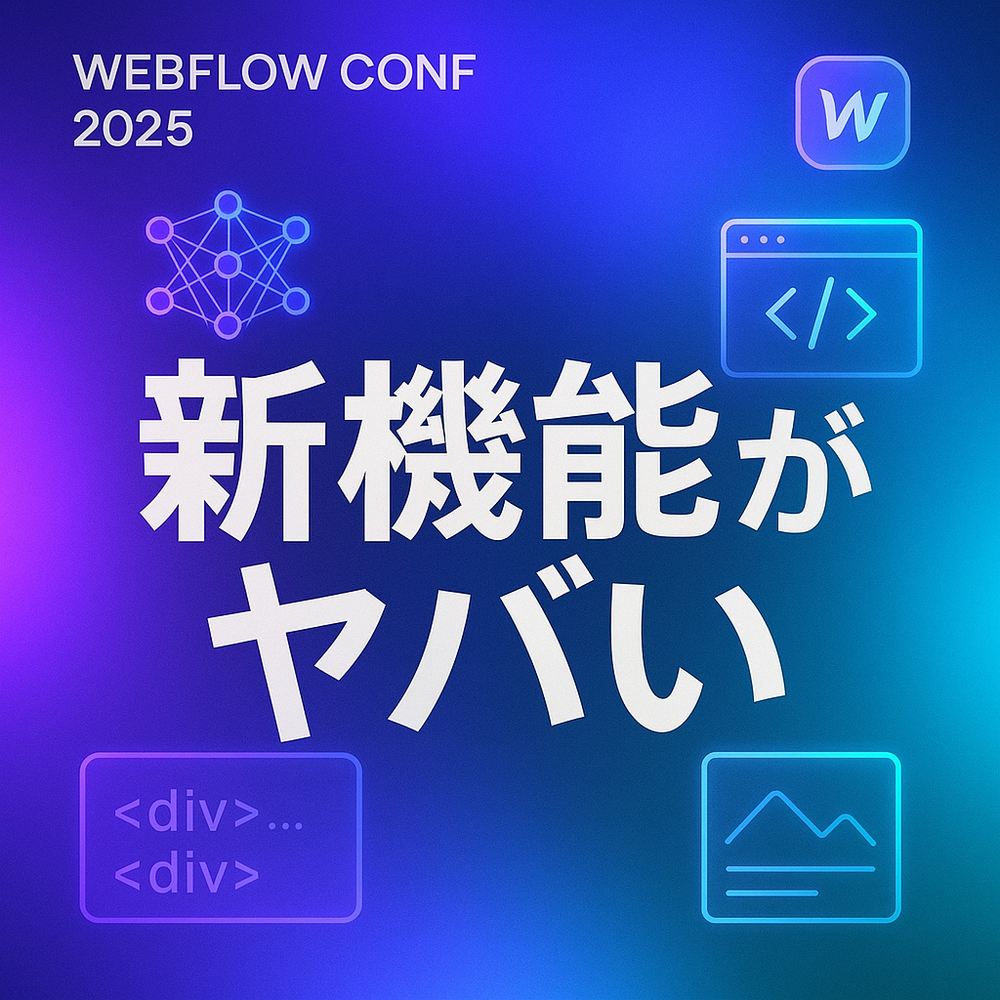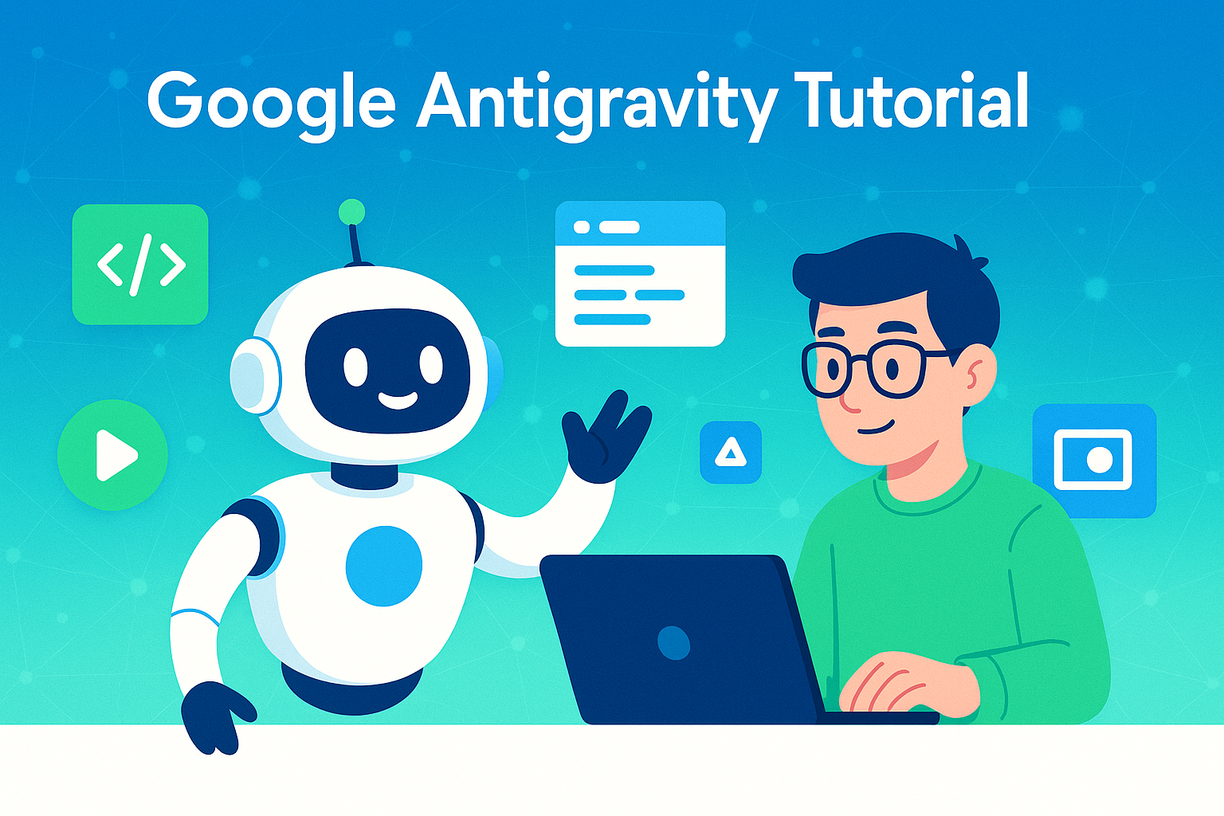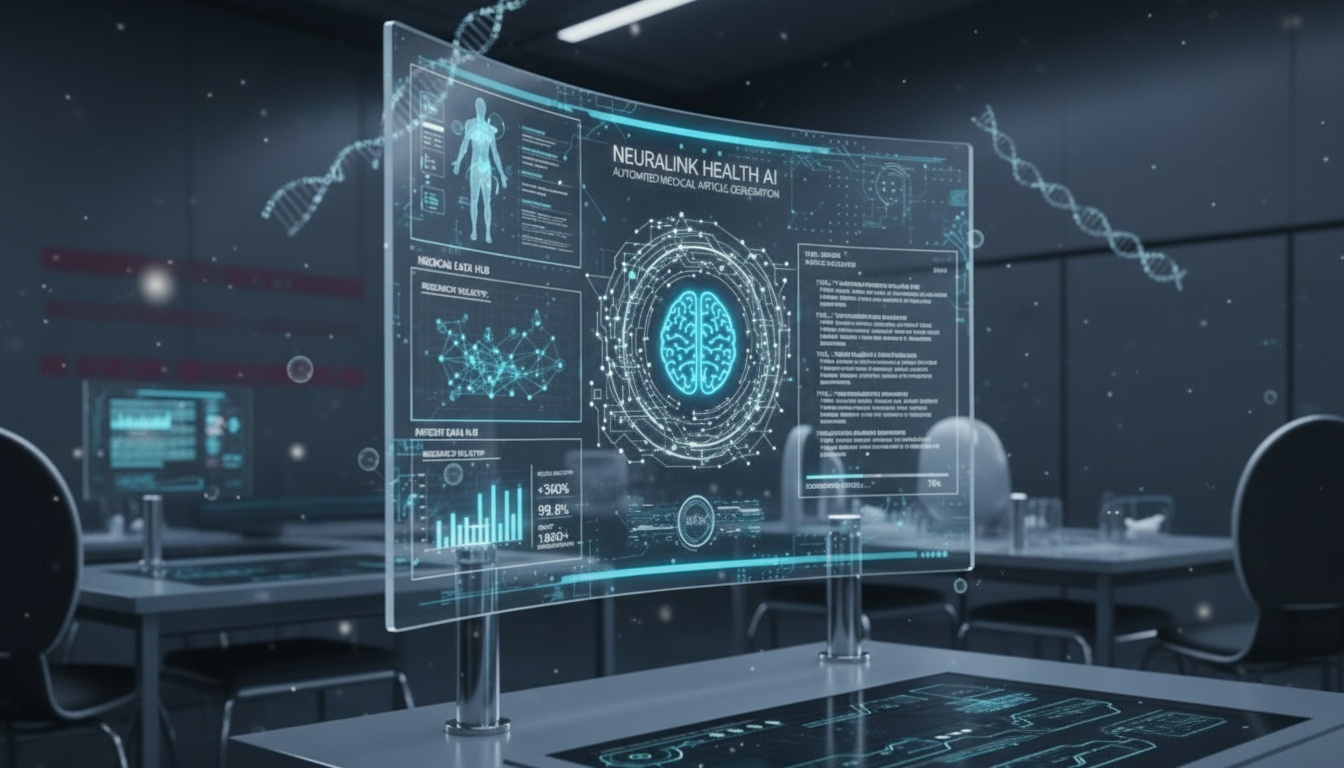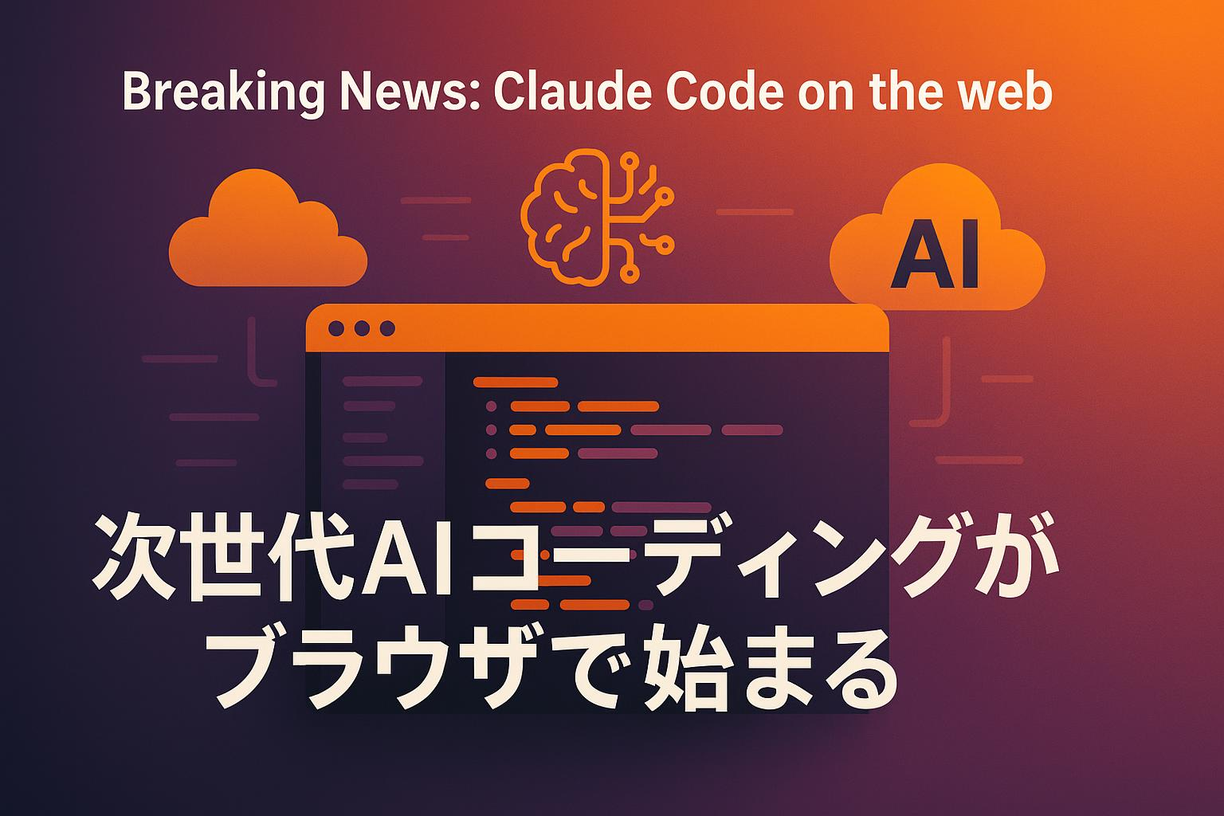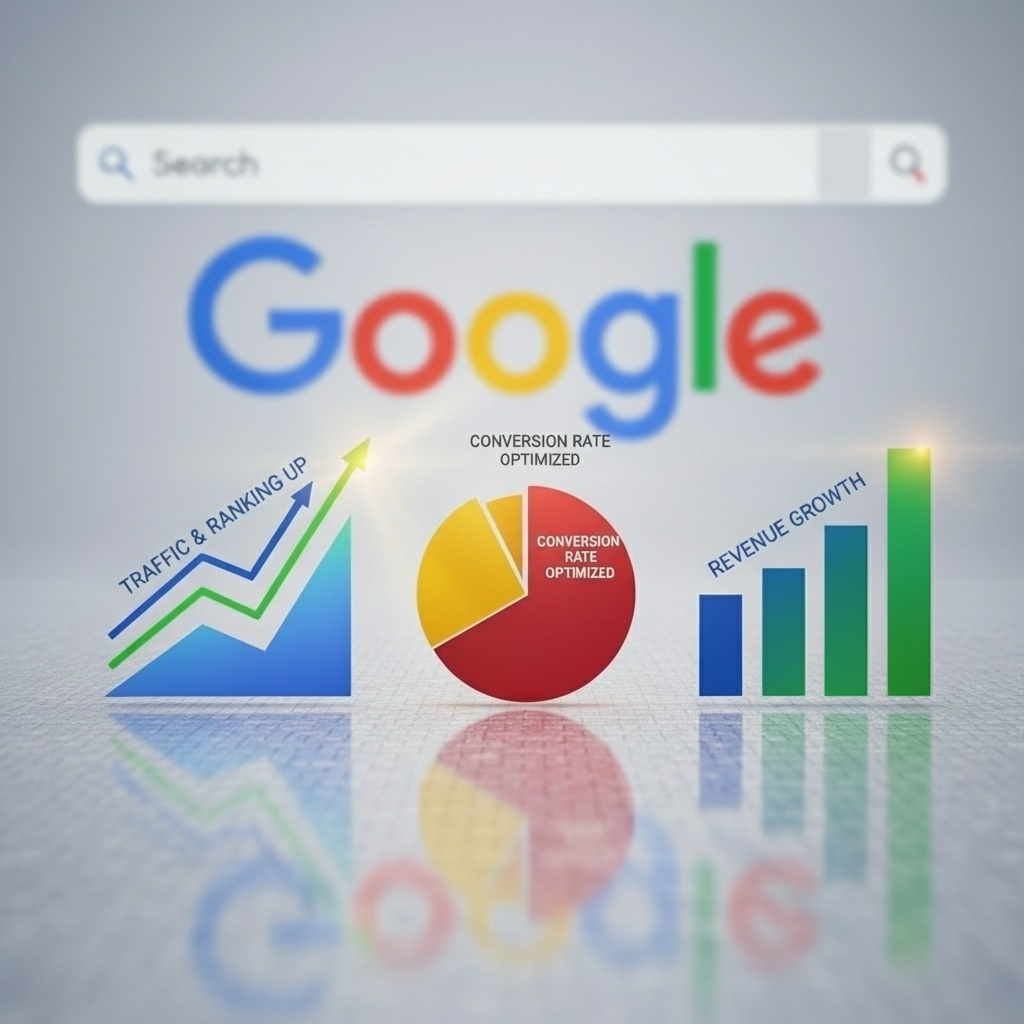Did you watch Webflow Conf 2025 that was held the other day? To be honest, I've thought many times, “This is seriously not going to change the way we work...” This announcement isn't just a level of additional functionality. The content was such that the common sense of web production was completely overturned.
So, what was announced in the keynote this time is “so, how can it be used in the actual field?” From that point of view, I will explain it in an easy-to-understand manner as much as possible.
1. First, let's get the big picture
Summarizing this announcement in a nutshell, it means “the era where AI becomes a partner in web production has begun in earnest.” The direction Webflow is aiming for can be broadly divided into 4 categories.
The idea of going from a prompt to a production environment is that you can create a web application that works just by talking to AI without having to ask a developer anymore. This is revolutionary for marketers and designers, isn't it?
Creating a bold first impression is when visitors say “Whoa!” It means making it easy to implement impressive animations and interactions like you think. This is an age where websites are no longer “just a mass of information,” but an experience itself.
Creating content that speaks to AI is about making content that can be found not only by Google but also by AI like ChatGPT and Perplexity. From now on, we are entering an age where we have to think not only about SEO, but also AEO (Answer Engine Optimization).
And implementing large-scale personalization makes it possible to efficiently provide experiences tailored to each visitor. By utilizing data, you will be able to operate your site more effectively.
2. What exactly will change? Notable new features
2-1.AI Assistant evolves from just an auxiliary tool to a “smart partner”
Until now, AI Assistants have also been useful, but the level of evolution this time is different. I understood the overall structure and design system of the site, and now I can entrust complicated tasks to them.
It's explained like this on the official blog.
“We've re-imagined AI Assistant as an intelligent, conversational partner that can coordinate complex tasks across the site. This allows the team to move faster without compromising quality.” [1]
For example, if you're a designer, you can simply ask “sort out class names for this entire page according to BEM rules,” and the process, which would take hours if done by hand, can be completed in an instant. If you're a content marketer, you can improve the SEO of the entire site all at once with instructions like “optimize meta descriptions for all blog posts within 120 characters.”
This may seem plain, but it means that the cost of maintaining a consistent design system will drop dramatically. Tasks that until now have been put on the back burner by saying “I know it's better to do it, but I don't have time...” can now be done quickly. This is big.
2-2. The era where web applications can be created with prompts has come
Personally, this was the one that shocked me the most. By simply instructing AI, it will be possible to generate web applications and React components that run in a production environment. Moreover, it can be deployed to Webflow Cloud with just one click.
What's so amazing about this is that until now it took a few weeks to “ask the development team, write specifications, review...”, and marketers and designers can do it themselves.
For example, if the marketing department thinks “I want to make a simulator that can compare rate plans,” they just ask AI to “make an interactive fee simulator that can compare and examine the 3 rate plans.” You don't have to wait for development team resources. This completely changes the sense of speed of lead acquisition campaigns, doesn't it?
Developers can also focus on more advanced customizations by letting AI create prototypes of components with complex logic. In other words, it's a feature that makes everyone happy.
Incidentally, this web application generation function uses a framework called Astro, and it seems that Webflow has also become an official sponsor of Astro. The seriousness is conveyed, isn't it?
2-3. CMS is now seriously enterprise-compatible
It seems that the architecture of the next generation CMS has been rebuilt from the ground up. What has changed is that it is now possible to handle tens of thousands or more content items. Until now, I was worried about performance for large sites, but that limitation will go away.
Furthermore, the Content Delivery API will be opened to all users. What this can do is that Webflow can now be used as a “headless CMS.” In other words, the same content can be distributed not only to websites, but also to mobile applications, digital signage, and various channels.
If it's a large-scale EC site, tens of thousands of product catalogs can be centrally managed with Webflow CMS and operated without worrying about performance. For global companies, distributing content from a single content database to every touchpoint around the world is becoming a reality.
Also, hosting infrastructure is moving significantly to Cloudflare's global network. Since it is a network deployed in 330 cities and 125 countries around the world, it is fast no matter where you access it. Security will also be strengthened, and downtime will also be reduced. Since you can automatically benefit from this, it means that the site will be faster even if you don't do anything.
2-4. Real-time collaboration that dramatically changes teamwork
Like Google Docs, multiple people will be able to work simultaneously on the same page. It's like the designer is fiddling with the layout, the copywriter is pouring in the text, and the marketer is setting up SEO.
Until now, people have been waiting in line like “once the designers are done, copywriters are next”, haven't they? It's going to go away. The speed at which the project progresses will be completely different.
Also, “comment-only links” are also moderately useful. Even people who don't have a Webflow account (client executives, legal affairs personnel, etc.) can review the site and leave comments with just one link. You don't have to say “Please create an account.” This makes the approval process insanely smooth, doesn't it?
3. Lots of other features not to be missed
3-1. AI-driven SEO features
AI drafts alt text, metadata, and even schema markup for you. Moreover, it seems that all users will be able to use it next month (2025/10).
Isn't it insanely difficult to write alt text one by one for a site with hundreds of pages? We can leave that up to AI. Furthermore, since an AI function that finds optimization opportunities has also been added to the audit panel, it also tells me “what to improve.”
From now on, the number of people searching for information on ChatGPT or Perplexity will increase, so it will become important not only for conventional SEO, but also for creating content that can be found by AI. Things like structured data and semantic HTML are becoming more important, aren't they?
3-2.Interactions with GSAP update
The integration with GSAP, which was announced earlier this year, will be even more powerful. The display can be controlled for each breakpoint, and code loading can be optimized. Accessibility settings will also be added, so you can even disable animations for users who are sensitive to movement.
Also, an integration with LottieFiles was announced. This makes it easier to incorporate complex animations, such as brand mascots, into the site.
3-3. Component Canvas
You'll be able to edit components in a separate environment outside of the page. You can see at a glance something like “if you change the style of this button, how will it affect 120 places on the entire site.”
It's an insanely useful feature for large-scale sites or people who want to create a solid design system.
3-4. Code components
This is a feature that has already been provided, but you can import external React components into WebFlow using DevLink. Developers can collaborate like implementing complex logic with React and designers adjusting visuals with Webflow.
For example, if you have an existing React component library, you can bring it into Webflow and the designer can style it. The boundary between development and design is becoming increasingly blurred.
3-5. Webflow Analyze Update
This will also be usable later this month (late September 2025), and something called “AI Traffic Insights” will be added. You can analyze the behavior of visitors coming from ChatGPT or Perplexity.
“Do people who come from AI searches have different behavior patterns from people who come from Google searches?” You'll be able to understand things like that. This is insanely important data when thinking about content strategies, isn't it?
Additionally, a goal reporting feature has been added, and conversions can be tracked directly within Webflow.
3-6. Form Updates
Notification settings can now be set individually for each form. It's like, “The inquiry form is for the sales department, and the recruitment form is for the HR department.”
Also, a spam inbox has been added, making it possible to restore legitimate inquiries that were mistakenly judged to be spam. It's plain, but it's a pretty helpful function in practice.
4. When can I start using it? What should I start with?
The release period differs depending on the function, so I'll sort it out.
The features you can already use are code components and Cloudflare infrastructure. In particular, Cloudflare automatically benefits, so the site should be faster even if you don't do anything.
The functions that can be used within 1 to 2 months are AI-driven SEO (to be offered next month) and the Webflow Analyze update (later this month). I think it would be a good idea for SEO personnel to try out alt text and metadata optimization as soon as next month.
Features that can be used within 3 to 6 months are AI Assistant updates, real-time collaboration, next-generation CMS, component canvas, Interactions with GSAP updates, dedicated comment links, and form updates. These will be rolled out sequentially in the latter half of 2025, so it might be a good idea to review the team's workflow now.
A feature that can be used in early 2025 is AI-driven code generation. This has the biggest impact, so it's a good idea to make a list of “what kind of web applications do you want to create” from now on.
5. Things you should prepare for now
In the short term, I think it would be a good idea to start reviewing SEO strategies and analyzing AI traffic. Also, if you have existing React assets, consider whether you can bring them into Webflow.
In the medium term, it's time to review the team's entire workflow. Once real-time collaboration can be used, the way “who does what at what timing” is carried out will change. If the design system is in place, AI Assistant can be used more effectively.
In the long run, there will come an age where even non-engineers can create web applications, so it might be a good idea to create guidelines on “how far we leave it to AI and where humans decide.” Also, it seems that AI prompt engineering skills will become important in the future.
7. Summary: Webflow is more than a “site builder”
What I thought when I saw this announcement is that Webflow isn't just a “website builder” anymore. It is about to become an enterprise-compatible “web development platform” centered on AI.
What only developers could do until now can now be done by designers and marketers. Conversely, developers will be able to focus on solving more complex and creative problems. An environment where everyone can focus on what they are good at is getting ready.
To keep up with this big wave of change, why not start learning new tools today? I think it's a good opportunity to review the team's skill set and think about “what will be needed in the coming era.”
Personally, I think 2025 will be a turning point that will go down in the history of web production. Let's enjoy this change together!
Bibliography
[1] Webflow. (2025, October 23). Everything we decided at Webflow Conf 2025. Webflow blog.

